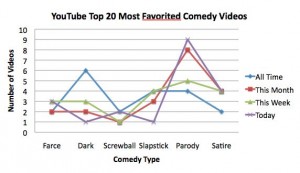Friday I did a “call for crowdsource help” on the YouTube/Comedy research I’m presenting at next week’s ISHS presentation. A big thanks for your comments, and especially to Will Reese. Check out this graphic…

Will’s categories (farce, dark, screwball, slapstick, parody, satire) were his own creation, and he found this interesting discover. Over shorter periods of time, a comedic video’s type is more likely to be diverse. Over longer periods of time, there’s more similarity.
Thanks also to Kiddsock, who is working on some analysis. Check out the sock puppet on YouTube because he’s underrated!
Now let’s observe some comments from YouTube, that are interesting even if not terribly helpful:
I’m afraid crowd humor is based on pain and fear and it freightens me. I think when its constructive pain and fear, like learning something new about yourself or others and reaching for the “good” it is really the funniest and is contagious. (carolperez)
I don’t really think people know what funny is any more. Everyone has conformed to this sick minded society and can turn something so innocent into something so wrong and laugh about it. Just the other day my roommate came upstairs laughing because he had watched a fake Steve Irwin death video. So explain to me how anyone in there right mind would find something like that funny. I know I am probably not making any since at all but what I’m trying to say is to make the people of the world laugh (Welcome2Broadway)
I do agree that some popular videos are sad statements on how our humor can be cruel or mean spirited, but I am not feeling like that’s “on the rise” permanently. I believe the anonymity of social media and online-video provides a temporary release for the darker side of humor, but that in the long run… good natured comedy will prevail.
P.S. Will Reese background: When in 1999 I saw the Internet as becoming a BFD, I joined a company called “Frontier Media Group,” which was evolving from a multi-media creator (video, kiosks, interactive CDs/DVDs) to a web-strategy firm. It was later acquired by Qwest telcom, and spun off to Cadient. That’s where I met Will, who was a lowly project lead at the time. Now he’s the company’s brain, and I’ve had the pleasure of watching him in pitches at major companies. If you’re pitching against Will, walk away.

Great work! Hats off to Will.
That parody ranks number is actually little surprise. I know that is my own bread butter in terms of successful videos in terms of views/favorites. And it is no secret. Take for example VenetianPrincess, when she stared out her channel was self-described as being “a little bit of everything. She had original songs, an ambitious sci-fi fantasy series and a whole lot more. Then somewhere on the way to becoming Youtube’s most subscribed female she made the switch to almost exclusively parody.
No question it is on Youtube. However, it is somewhat of a matter of concern. How can be something more than the mainstream outlets if the best way to succeed is through parodying their product. We will remain for every not ready for prime time.
It would be interested to see if data could be produced for what was being favorite in 2006-2008 to see if viewers tastes have changed substantially since the earlier days of youtube.
Thank Kev! Still working on getting through the videos (putting my Subscriptions and video making aside.) So it should be interesting.
Might I suggest a different presentation of this particular data?
A bar chart (instead of a line graph) would be more appropriate here since this is a comparison of different comedy types (instead of a plot of values against an independent variable). In general, if you can’t interpolate between data points in a meaningful way, a line graph is inherently misleading.
Like this perhaps?
http://k.min.us/id4twc.png
Where would Happy Tree Friends fall in Reese’s categorization scheme? Would it be dark or would it be slapstick? It’s really both, but considering the popularity of HTF, where it was plugged in would have a huge influence on the shape of Reese’s graph!
………………. From http http://www.metrolyrics.com something-like-that-lyrics-nwa.html …………………………………………
I’ll be interested to see the results of this. I would have loved to have made my own contribution, but I was really busy with work. Looks like you got plenty of good help, though.